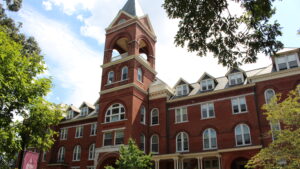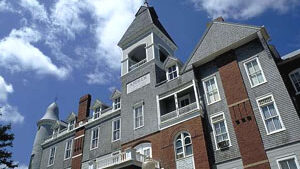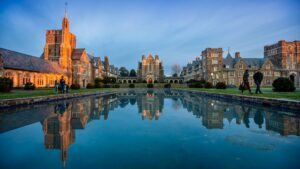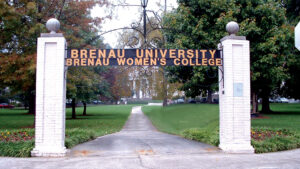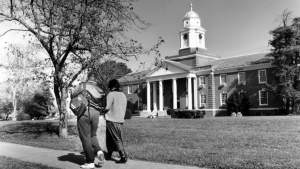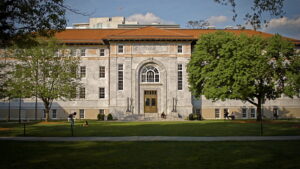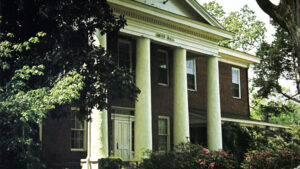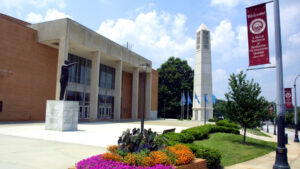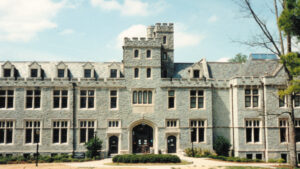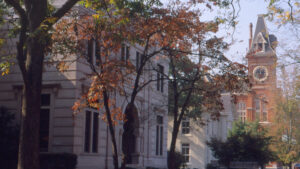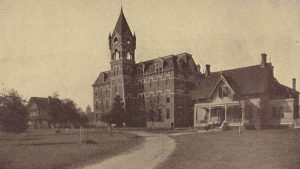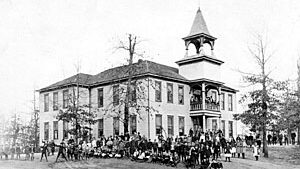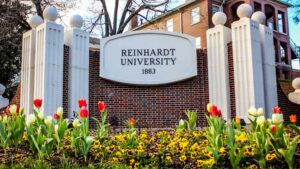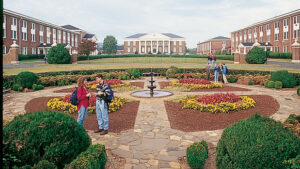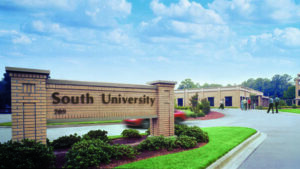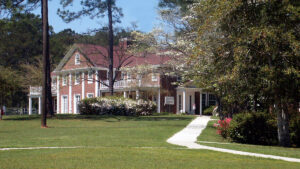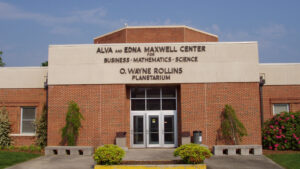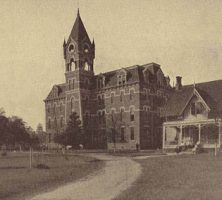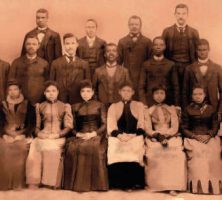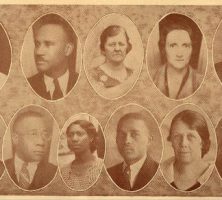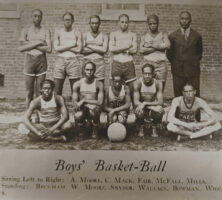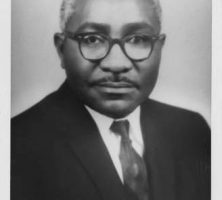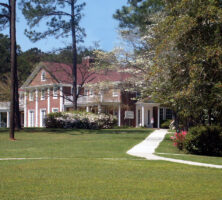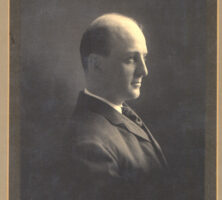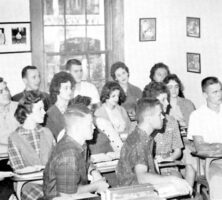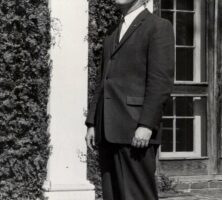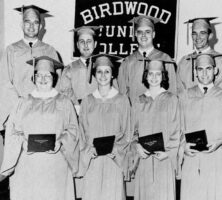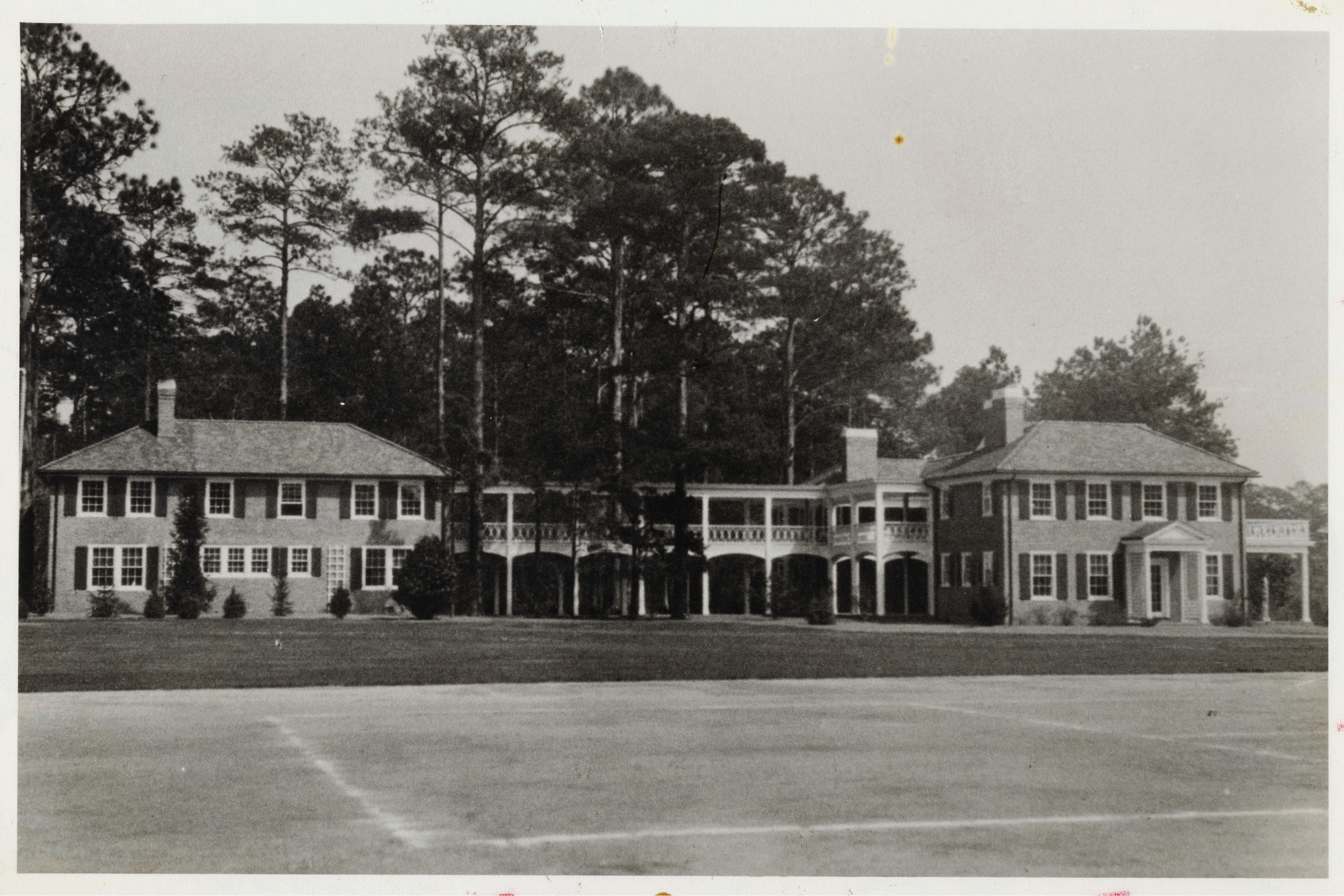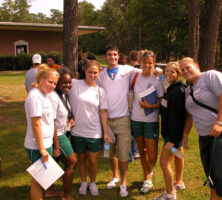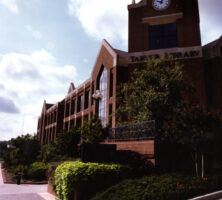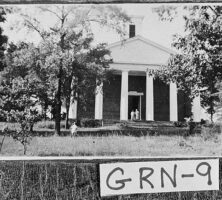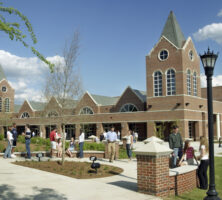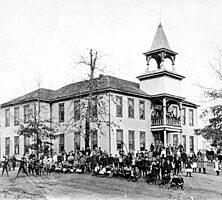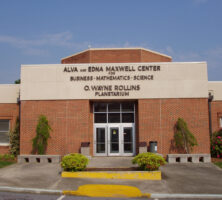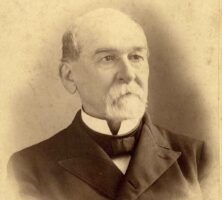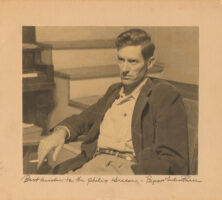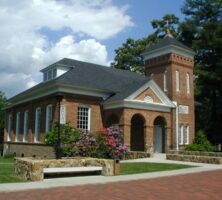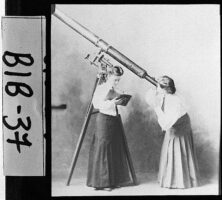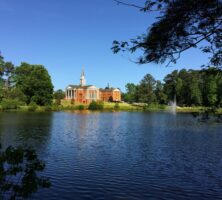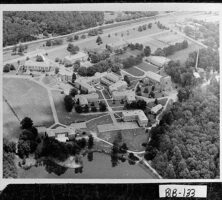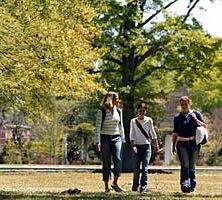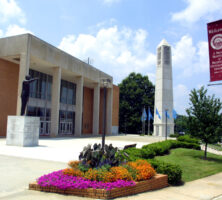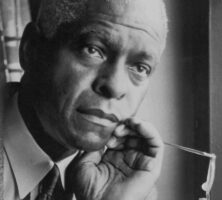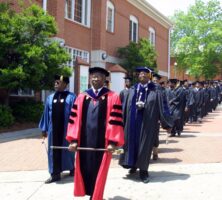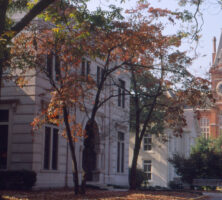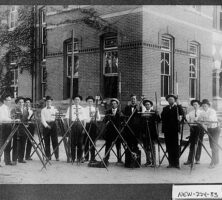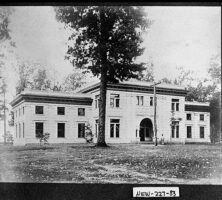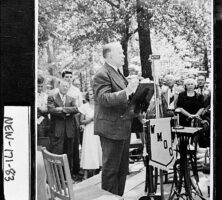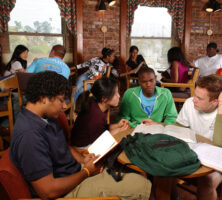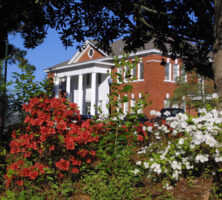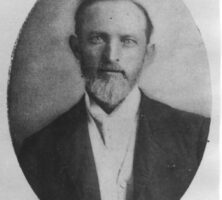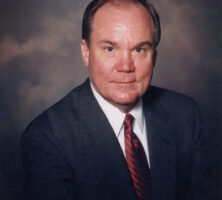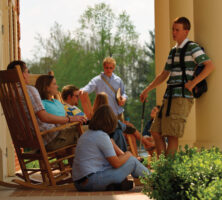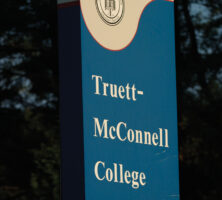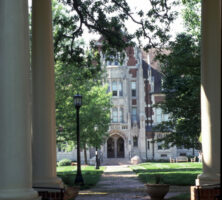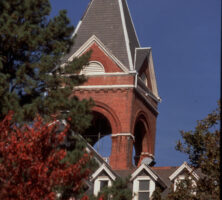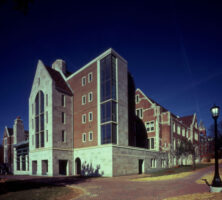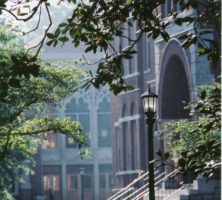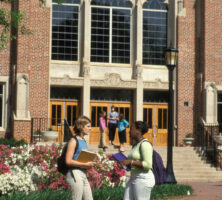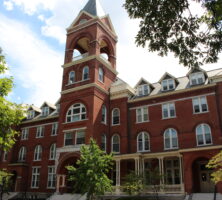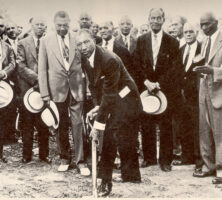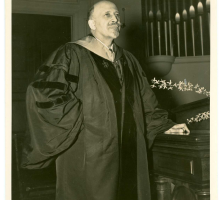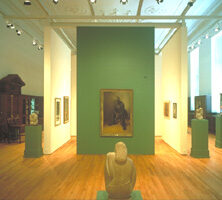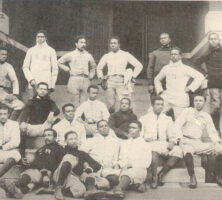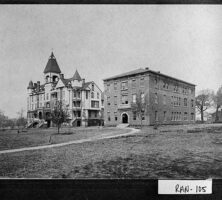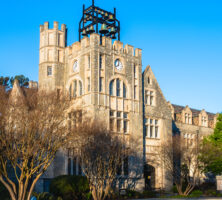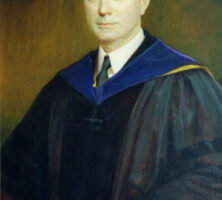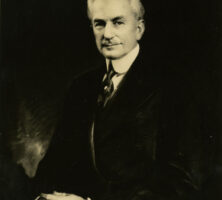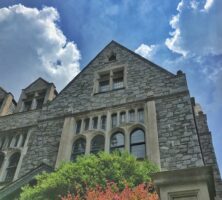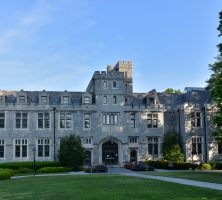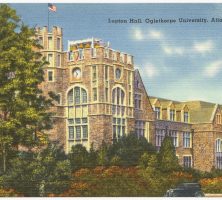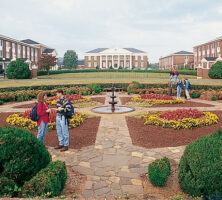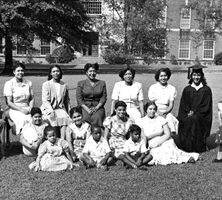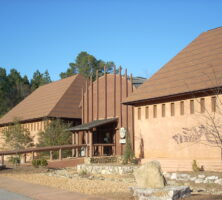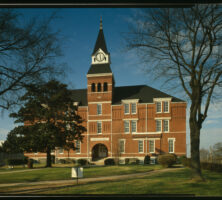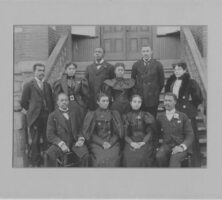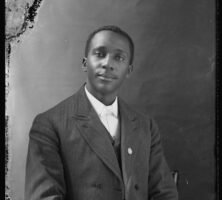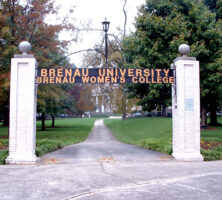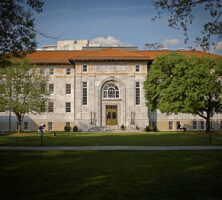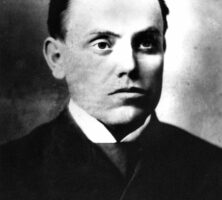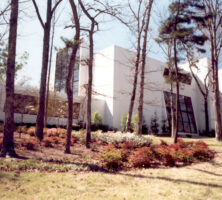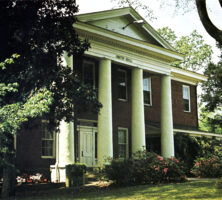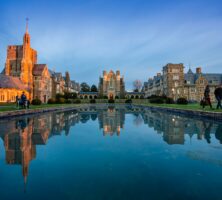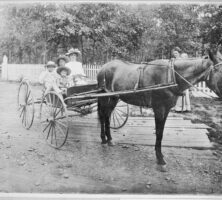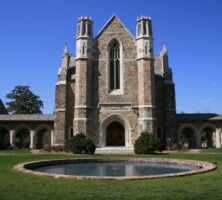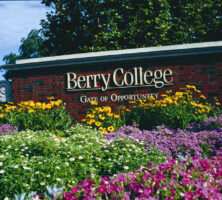The New Georgia Encyclopedia is supported by funding from A More Perfect Union, a special initiative of the National Endowment for the Humanities.
Haygood Hall (left) and Holsey Hall are pictured in 1899 on the campus of Paine College, a historically Black liberal arts college in Augusta.
Courtesy of Paine College
The New Georgia Encyclopedia does not hold the copyright for this media resource and can neither grant nor deny permission to republish or reproduce the image online or in print. All requests for permission to publish or reproduce the resource must be submitted to the rights holder.
As bishop of the Colored Methodist Episcopal Church, Lucius Holsey oversaw the growth of the denomination in his native state of Georgia. He was also instrumental in the establishment of Paine Institute (later Paine College), which opened in Augusta in 1884.
Photograph by Mathew B. Brady. Courtesy of National Archives and Records Administration
The New Georgia Encyclopedia does not hold the copyright for this media resource and can neither grant nor deny permission to republish or reproduce the image online or in print. All requests for permission to publish or reproduce the resource must be submitted to the rights holder.
The 1891 class of the Paine College normal school, which trained preachers and teachers, is pictured. The college was founded in Augusta in 1884 to provide a liberal arts education to African American students of both genders.
Courtesy of Paine College
The New Georgia Encyclopedia does not hold the copyright for this media resource and can neither grant nor deny permission to republish or reproduce the image online or in print. All requests for permission to publish or reproduce the resource must be submitted to the rights holder.
The faculty of Paine College, a historically Black college in Augusta, is pictured in 1936. The faculty was all white upon the college's opening in 1884 and was integrated four years later, when its first Black faculty member, John Wesley Gilbert, was hired.
Courtesy of Paine College
The New Georgia Encyclopedia does not hold the copyright for this media resource and can neither grant nor deny permission to republish or reproduce the image online or in print. All requests for permission to publish or reproduce the resource must be submitted to the rights holder.
The Paine College men's basketball team is pictured in 1930. Sitting, left to right: A. Moore, C. Mack, Fair, McFall, Mills. Standing, left to right: Beckham, W. Moore, Snyder, Wallace, Bowman, and Wiggins (coach).
Courtesy of Paine College
The New Georgia Encyclopedia does not hold the copyright for this media resource and can neither grant nor deny permission to republish or reproduce the image online or in print. All requests for permission to publish or reproduce the resource must be submitted to the rights holder.
The New Georgia Encyclopedia does not hold the copyright for this media resource and can neither grant nor deny permission to republish or reproduce the image online or in print. All requests for permission to publish or reproduce the resource must be submitted to the rights holder.
Dr. Lucius Holsey Pitts, a member of the Paine College class of 1941, is pictured in 1971, when he became the college's first Black president.
Courtesy of Paine College
The New Georgia Encyclopedia does not hold the copyright for this media resource and can neither grant nor deny permission to republish or reproduce the image online or in print. All requests for permission to publish or reproduce the resource must be submitted to the rights holder.
The New Georgia Encyclopedia does not hold the copyright for this media resource and can neither grant nor deny permission to republish or reproduce the image online or in print. All requests for permission to publish or reproduce the resource must be submitted to the rights holder.
Forbes Hall, on the campus of Thomas University in Thomasville, houses the president's office, as well as the administration and athletic offices. The building originally served as the main house of Birdwood Plantation, which was built in 1932 as a winter resort for W. Cameron Forbes, a U.S. ambassador to Japan.
Courtesy of Thomas University
The New Georgia Encyclopedia does not hold the copyright for this media resource and can neither grant nor deny permission to republish or reproduce the image online or in print. All requests for permission to publish or reproduce the resource must be submitted to the rights holder.
W. Cameron Forbes, a U.S. ambassador to Japan and one-time governor of the Philippines, established Birdwood Plantation in Thomas County in 1932. During the 1950s his plantation was converted into Birdwood College, which later became Thomas University.
Courtesy of Thomas University
The New Georgia Encyclopedia does not hold the copyright for this media resource and can neither grant nor deny permission to republish or reproduce the image online or in print. All requests for permission to publish or reproduce the resource must be submitted to the rights holder.
Students attend class at Birdwood College, which later became Thomas University, in Thomasville during the 1960s. Enrollment at Birdwood College declined during this decade due to its lack of accreditation and limited academic offerings.
Courtesy of Thomas University
The New Georgia Encyclopedia does not hold the copyright for this media resource and can neither grant nor deny permission to republish or reproduce the image online or in print. All requests for permission to publish or reproduce the resource must be submitted to the rights holder.
J. Harley Chapman founded Birdwood College, a school originally affiliated with the Primitive Baptist denomination, in Thomasville in 1950, and classes began four years later. Known today as Thomas University, the school is a nonsectarian, private, and independent institution offering associate's, bachelor's, and master's degrees.
Courtesy of Thomas University
The New Georgia Encyclopedia does not hold the copyright for this media resource and can neither grant nor deny permission to republish or reproduce the image online or in print. All requests for permission to publish or reproduce the resource must be submitted to the rights holder.
Graduates of Birdwood College are pictured in the 1960s. The college, founded in Thomasville by Primitive Baptists, opened in 1954 and operated until 1977, when the school became a nonsectarian institution called Thomas County Community College. By 2000 the college had evolved into Thomas University.
Courtesy of Thomas University
The New Georgia Encyclopedia does not hold the copyright for this media resource and can neither grant nor deny permission to republish or reproduce the image online or in print. All requests for permission to publish or reproduce the resource must be submitted to the rights holder.
The Birdwood Annex (left) is attached to Forbes Hall, the administration building on the campus of Thomas University in Thomasville. The annex houses faculty offices, as well as the office for institutional advancement.
Courtesy of Thomas University
The New Georgia Encyclopedia does not hold the copyright for this media resource and can neither grant nor deny permission to republish or reproduce the image online or in print. All requests for permission to publish or reproduce the resource must be submitted to the rights holder.
Students at Thomas University in Thomasville are pictured circa 2008. The university's student body comes primarily from south Georgia and north Florida to pursue undergraduate and graduate degrees at the private institution.
Courtesy of Thomas University
The New Georgia Encyclopedia does not hold the copyright for this media resource and can neither grant nor deny permission to republish or reproduce the image online or in print. All requests for permission to publish or reproduce the resource must be submitted to the rights holder.
The Jack Tarver Library, located on the Mercer University campus in Macon, is named for Jackson Williams Tarver, a prominent Georgia journalist and businessman. Tarver graduated from Mercer University in 1938, with a degree in journalism.
Courtesy of Mercer University
The New Georgia Encyclopedia does not hold the copyright for this media resource and can neither grant nor deny permission to republish or reproduce the image online or in print. All requests for permission to publish or reproduce the resource must be submitted to the rights holder.
Penfield Baptist Church, pictured in the 1940s, was built in 1845 as the chapel for Mercer University in Penfield. The university gave the chapel to Penfield Baptist Church in 1871, when the campus moved to Macon.
Courtesy of Georgia Archives, Vanishing Georgia, #
grn009.
The New Georgia Encyclopedia does not hold the copyright for this media resource and can neither grant nor deny permission to republish or reproduce the image online or in print. Requests for permission to publish or reproduce the resource should be submitted to the Georgia Archives.
The New Georgia Encyclopedia does not hold the copyright for this media resource and can neither grant nor deny permission to republish or reproduce the image online or in print. All requests for permission to publish or reproduce the resource must be submitted to the rights holder.
the Knight Hall of Mercer University in Macon, Georgia. In 1912, when the citizens of Macon pledged support to the university, school administrators decided against moving the campus to Atlanta.
Image from Brandon Dolley
The New Georgia Encyclopedia does not hold the copyright for this media resource and can neither grant nor deny permission to republish or reproduce the image online or in print. All requests for permission to publish or reproduce the resource must be submitted to the rights holder.
Members of the Baptist association at Mercer University gather on the school's former grounds in Penfield, circa 1949. The college was founded in Penfield in 1833 with a gift from the Georgia Baptist Convention. In 1871 the campus moved to Macon, where it remains today.
Courtesy of Georgia Archives, Vanishing Georgia, #
grn008.
The New Georgia Encyclopedia does not hold the copyright for this media resource and can neither grant nor deny permission to republish or reproduce the image online or in print. Requests for permission to publish or reproduce the resource should be submitted to the Georgia Archives.
The University Center at Mercer University in Macon offers a fitness center, a swimming pool, and an arena for sporting events and concerts. The center also includes a bookstore and dining facilities.
Courtesy of Mercer University
The New Georgia Encyclopedia does not hold the copyright for this media resource and can neither grant nor deny permission to republish or reproduce the image online or in print. All requests for permission to publish or reproduce the resource must be submitted to the rights holder.
The J. S. Green Collegiate Institute, founded by the Reverend Charles C. Spence, opened in Demorest in 1897 and offered classes ranging in level from the first grade to college. In 1901 the school was adopted by the American Missionary Association, and its name was changed to Piedmont College.
Courtesy of Piedmont College
The New Georgia Encyclopedia does not hold the copyright for this media resource and can neither grant nor deny permission to republish or reproduce the image online or in print. All requests for permission to publish or reproduce the resource must be submitted to the rights holder.
The New Georgia Encyclopedia does not hold the copyright for this media resource and can neither grant nor deny permission to republish or reproduce the image online or in print. All requests for permission to publish or reproduce the resource must be submitted to the rights holder.
The New Georgia Encyclopedia does not hold the copyright for this media resource and can neither grant nor deny permission to republish or reproduce the image online or in print. All requests for permission to publish or reproduce the resource must be submitted to the rights holder.
The New Georgia Encyclopedia does not hold the copyright for this media resource and can neither grant nor deny permission to republish or reproduce the image online or in print. All requests for permission to publish or reproduce the resource must be submitted to the rights holder.
The New Georgia Encyclopedia does not hold the copyright for this media resource and can neither grant nor deny permission to republish or reproduce the image online or in print. All requests for permission to publish or reproduce the resource must be submitted to the rights holder.
The Rollins Planetarium at Young Harris College opened in 1979 and is one of the largest in the state.
Courtesy of Kent Montgomery
The New Georgia Encyclopedia does not hold the copyright for this media resource and can neither grant nor deny permission to republish or reproduce the image online or in print. All requests for permission to publish or reproduce the resource must be submitted to the rights holder.
Young L. G. Harris, a judge from Athens, was an early benefactor of Young Harris College, which was named in his honor by Artemus Lester, the school's founder.
Courtesy of Young Harris College
The New Georgia Encyclopedia does not hold the copyright for this media resource and can neither grant nor deny permission to republish or reproduce the image online or in print. All requests for permission to publish or reproduce the resource must be submitted to the rights holder.
Renowned poet Byron Herbert Reece, a native of Dahlonega, attended Young Harris College, although he never completed a degree. Reece returned to the school as an instructor in the 1950s.
Courtesy of Hargrett Rare Book and Manuscript Library, University of Georgia Libraries, Byron Herbert Reece Papers.
The New Georgia Encyclopedia does not hold the copyright for this media resource and can neither grant nor deny permission to republish or reproduce the image online or in print. Requests for permission to publish or reproduce the resource should be submitted to the Hargrett Manuscript and Rare Book Library at the University of Georgia.
The Susan B. Harris Chapel stands on the campus of Young Harris College, a four-year liberal arts institution in Towns County. The school, affiliated with the Methodist Church, was founded in 1886 and has produced such notable alumni as U.S. senator Zell Miller, actor Oliver Hardy, and musician Trisha Yearwood.
Courtesy of Young Harris College
The New Georgia Encyclopedia does not hold the copyright for this media resource and can neither grant nor deny permission to republish or reproduce the image online or in print. All requests for permission to publish or reproduce the resource must be submitted to the rights holder.
Students at Wesleyan Female College, later Wesleyan College, in Macon study astronomy in 1905. The college was not only the first institution of higher education to grant degrees to women, but was also notable for its emphasis on mathematics and science courses.
Courtesy of Georgia Archives, Vanishing Georgia, #
bib037.
The New Georgia Encyclopedia does not hold the copyright for this media resource and can neither grant nor deny permission to republish or reproduce the image online or in print. Requests for permission to publish or reproduce the resource should be submitted to the Georgia Archives.
Wesleyan College, located in Macon, was chartered in 1836 as the first degree-granting women's college in the world. Today approximately 700 students are enrolled at the four-year liberal arts school.
Photograph by Farrargirl
The New Georgia Encyclopedia does not hold the copyright for this media resource and can neither grant nor deny permission to republish or reproduce the image online or in print. All requests for permission to publish or reproduce the resource must be submitted to the rights holder.
Georgia Female College, founded in Macon by the Methodist Church in 1836, became Wesleyan Female College in 1843. The name change honored Methodism's founder, John Wesley. In 1917 the school's current name, Wesleyan College, was adopted.
Courtesy of Georgia Archives, Vanishing Georgia, #
bib011.
The New Georgia Encyclopedia does not hold the copyright for this media resource and can neither grant nor deny permission to republish or reproduce the image online or in print. Requests for permission to publish or reproduce the resource should be submitted to the Georgia Archives.
The Adelphean Room, located in the Alpha Delta Pi sorority house at Wesleyan College in Macon, is named in honor of the Adelphean Society, which was founded at the school in 1851. Later renamed Alpha Delta Pi, the society is considered to be the mother of the modern sorority system.
Courtesy of Georgia Archives, Vanishing Georgia, #
bib136.
The New Georgia Encyclopedia does not hold the copyright for this media resource and can neither grant nor deny permission to republish or reproduce the image online or in print. Requests for permission to publish or reproduce the resource should be submitted to the Georgia Archives.
Wesleyan College moved from downtown Macon to its current location in the suburb of Rivoli in 1928. The original master architecture and landscape plan has been maintained since that time, and the campus was named a National Register Historic District in 2004.
Courtesy of Georgia Archives, Vanishing Georgia, #
bib133.
The New Georgia Encyclopedia does not hold the copyright for this media resource and can neither grant nor deny permission to republish or reproduce the image online or in print. Requests for permission to publish or reproduce the resource should be submitted to the Georgia Archives.
Wesleyan College, a four-year liberal arts college for women, is ranked among the nation's top liberal arts colleges for diversity. Located in Macon, the school offers twenty-nine undergraduate majors, as well as eight preprofessional programs and two master's degrees.
Courtesy of Wesleyan College
The New Georgia Encyclopedia does not hold the copyright for this media resource and can neither grant nor deny permission to republish or reproduce the image online or in print. All requests for permission to publish or reproduce the resource must be submitted to the rights holder.
The Martin Luther King Jr. International Chapel was built on the Morehouse University campus to honor one of the school's most prestigious alumni. The chapel's mission is to continue King's work by welcoming adherents of all faiths who "embody the vision of peace."
Courtesy of Morehouse College
The New Georgia Encyclopedia does not hold the copyright for this media resource and can neither grant nor deny permission to republish or reproduce the image online or in print. All requests for permission to publish or reproduce the resource must be submitted to the rights holder.
John Hope, the first Black president of both Morehouse College and Atlanta University (later Clark Atlanta University), was an important African American educator and race leader of the early twentieth century.
Image from The Crisis, Vol 8, No 1, May 1914
The New Georgia Encyclopedia does not hold the copyright for this media resource and can neither grant nor deny permission to republish or reproduce the image online or in print. All requests for permission to publish or reproduce the resource must be submitted to the rights holder.
After a period of decline during the 1930s, Morehouse College emerged as a thriving institution under the guidance of Benjamin Mays, who served as the school's president from 1940 until 1967. During his tenure, Mays encouraged both faculty and students, including the young Martin Luther King Jr., to become involved in the civil rights movement.
Courtesy of Morehouse College
The New Georgia Encyclopedia does not hold the copyright for this media resource and can neither grant nor deny permission to republish or reproduce the image online or in print. All requests for permission to publish or reproduce the resource must be submitted to the rights holder.
Graduates of Morehouse University in Atlanta, one of the most prestigious historically Black colleges in the nation, proceed through campus during a baccalaureate ceremony.
Courtesy of Morehouse College
The New Georgia Encyclopedia does not hold the copyright for this media resource and can neither grant nor deny permission to republish or reproduce the image online or in print. All requests for permission to publish or reproduce the resource must be submitted to the rights holder.
Oxford College, located in Newton County, serves as the undergraduate school for freshman and sophomores admitted to Emory University in Atlanta.
Courtesy of Emory University
The New Georgia Encyclopedia does not hold the copyright for this media resource and can neither grant nor deny permission to republish or reproduce the image online or in print. All requests for permission to publish or reproduce the resource must be submitted to the rights holder.
An engineering class meets on the campus of Emory College in 1908. In 1919 the college relocated to Atlanta and later became Emory University. Today the historic Oxford campus is known as Oxford College and offers the first two years of the university's undergraduate curriculum.
Courtesy of Georgia Archives, Vanishing Georgia, #
new224-83.
The New Georgia Encyclopedia does not hold the copyright for this media resource and can neither grant nor deny permission to republish or reproduce the image online or in print. Requests for permission to publish or reproduce the resource should be submitted to the Georgia Archives.
Candler Hall, pictured in 1908 on the campus of Emory College (later Oxford College of Emory University) in Newton County, was built in 1897 to house a library. The building was named in honor of Warren Akin Candler, the president of the college from 1888 to 1898.
Courtesy of Georgia Archives, Vanishing Georgia, #
new227-83.
The New Georgia Encyclopedia does not hold the copyright for this media resource and can neither grant nor deny permission to republish or reproduce the image online or in print. Requests for permission to publish or reproduce the resource should be submitted to the Georgia Archives.
Alben Barkley, a distinguished alumnus of Oxford College, speaks on campus around 1950. Barkley, a native of Kentucky, became vice president of the United States under Harry S. Truman in 1948.
Courtesy of Georgia Archives, Vanishing Georgia, #
new171-83.
The New Georgia Encyclopedia does not hold the copyright for this media resource and can neither grant nor deny permission to republish or reproduce the image online or in print. Requests for permission to publish or reproduce the resource should be submitted to the Georgia Archives.
Students at Oxford College of Emory University gather in Candler Hall to study and socialize. The school's residential student body numbers around 600 each year, and approximately 90 percent of Oxford students will continue their studies at Emory University in Atlanta.
Courtesy of Emory University Photography
The New Georgia Encyclopedia does not hold the copyright for this media resource and can neither grant nor deny permission to republish or reproduce the image online or in print. All requests for permission to publish or reproduce the resource must be submitted to the rights holder.
Brewton-Parker College is a four-year institution affiliated with the Georgia Baptist Convention. Built in 1904, the same year as the school's founding, Gates Hall, pictured, is the only original building still standing on the college's main campus, which is located in Mount Vernon.
Courtesy of Terry Gaston, Brewton-Parker College
The New Georgia Encyclopedia does not hold the copyright for this media resource and can neither grant nor deny permission to republish or reproduce the image online or in print. All requests for permission to publish or reproduce the resource must be submitted to the rights holder.
In 1904 John Carter Brewton, a Baptist pastor, cofounded the Union Baptist Institute in Montgomery County to provide elementary and secondary Christian education to children in south Georgia. The school later became Brewton-Parker College, a four-year liberal arts college.
Courtesy of Brewton-Parker College Archives
The New Georgia Encyclopedia does not hold the copyright for this media resource and can neither grant nor deny permission to republish or reproduce the image online or in print. All requests for permission to publish or reproduce the resource must be submitted to the rights holder.
The New Georgia Encyclopedia does not hold the copyright for this media resource and can neither grant nor deny permission to republish or reproduce the image online or in print. All requests for permission to publish or reproduce the resource must be submitted to the rights holder.
Built in 1934, the Arch at Brewton-Parker College is symbolic of two significant unions in the school's history. The Telfair and Daniell Baptist associations collaborated to establish the school, while the towns of Mount Vernon and Ailey jointly donated the land and capital for its construction in 1904. One leg of the arch stands in each of these towns.
Courtesy of Terry Gaston, Brewton-Parker College
The New Georgia Encyclopedia does not hold the copyright for this media resource and can neither grant nor deny permission to republish or reproduce the image online or in print. All requests for permission to publish or reproduce the resource must be submitted to the rights holder.
South University, a private academic institution in Savannah, was founded in 1899 as Draughon's Practical Business College. Today the school offers degree programs in business and health disciplines.
Courtesy of South University
The New Georgia Encyclopedia does not hold the copyright for this media resource and can neither grant nor deny permission to republish or reproduce the image online or in print. All requests for permission to publish or reproduce the resource must be submitted to the rights holder.
The South University clock tower is situated on the southwest corner of the school's campus in downtown Savannah. Located at its current site since 1974, the university has been housed at various addresses in Savannah since its founding in 1899.
Courtesy of South University
The New Georgia Encyclopedia does not hold the copyright for this media resource and can neither grant nor deny permission to republish or reproduce the image online or in print. All requests for permission to publish or reproduce the resource must be submitted to the rights holder.
Draughon's Practical Business College in Savannah was purchased by the family of John T. South III in 1974. South served as president of the school, renamed South University in 2001, for more than twenty years and continues to serve as chancellor.
Courtesy of South University
The New Georgia Encyclopedia does not hold the copyright for this media resource and can neither grant nor deny permission to republish or reproduce the image online or in print. All requests for permission to publish or reproduce the resource must be submitted to the rights holder.
The School of Health Professions at South University has offered associate and bachelor's degrees in physician assistant studies and physical therapy assisting since 1997. Medical laboratories on campus give students an opportunity to apply knowledge gained in the classroom.
Courtesy of South University
The New Georgia Encyclopedia does not hold the copyright for this media resource and can neither grant nor deny permission to republish or reproduce the image online or in print. All requests for permission to publish or reproduce the resource must be submitted to the rights holder.
The New Georgia Encyclopedia does not hold the copyright for this media resource and can neither grant nor deny permission to republish or reproduce the image online or in print. All requests for permission to publish or reproduce the resource must be submitted to the rights holder.
Students at Truett McConnell University, a four-year Baptist school in Cleveland, gather on the porch of the student center in 2003. The Truett McConnell campus includes a chapel, gymnasium, library, dining hall, and residence halls.
Courtesy of Truett McConnell University
The New Georgia Encyclopedia does not hold the copyright for this media resource and can neither grant nor deny permission to republish or reproduce the image online or in print. All requests for permission to publish or reproduce the resource must be submitted to the rights holder.
Truett McConnell University, founded in Cleveland in 1946, is a four-year Baptist school with an enrollment of 733 full-time undergraduates in fall 2015. The school is named in honor of George W. Truett and Fernando C. McConnell, two cousins and Baptist ministers who dreamed of opening a school for Christian education in north Georgia. The school changed its name from Truett-McConnell College in 2016.
Courtesy of Truett McConnell University
The New Georgia Encyclopedia does not hold the copyright for this media resource and can neither grant nor deny permission to republish or reproduce the image online or in print. All requests for permission to publish or reproduce the resource must be submitted to the rights holder.
A student at Truett McConnell University engages in an "applied lesson," which typically involves one-on-one instruction. Truett McConnell offers fourteen bachelor's degree programs of study, including one in music.
Courtesy of Truett McConnell University
The New Georgia Encyclopedia does not hold the copyright for this media resource and can neither grant nor deny permission to republish or reproduce the image online or in print. All requests for permission to publish or reproduce the resource must be submitted to the rights holder.
Buttrick Hall is the main academic building for Agnes Scott College. The building holds classrooms and faculty and staff offices.
Courtesy of Agnes Scott College
The New Georgia Encyclopedia does not hold the copyright for this media resource and can neither grant nor deny permission to republish or reproduce the image online or in print. All requests for permission to publish or reproduce the resource must be submitted to the rights holder.
The bell tower of Agnes Scott Hall can be seen from the downtown Decatur area and surrounding neighborhoods. The building, also known as "Main," was built in 1891 and today houses dormitories and meeting space.
Courtesy of Agnes Scott College
The New Georgia Encyclopedia does not hold the copyright for this media resource and can neither grant nor deny permission to republish or reproduce the image online or in print. All requests for permission to publish or reproduce the resource must be submitted to the rights holder.
A new addition to McCain Library opened in January 2001 after extensive renovation projects were completed in December 2000. Originally the Andrew Carnegie Library at its opening in 1910, McCain Library was so named in 1951 for James Ross McCain, second president of the college, at the time of his retirement.
Courtesy of Agnes Scott College
The New Georgia Encyclopedia does not hold the copyright for this media resource and can neither grant nor deny permission to republish or reproduce the image online or in print. All requests for permission to publish or reproduce the resource must be submitted to the rights holder.
Main building, also known as Agnes Scott Hall, is on the right. In the background is the Letitia Pate Evans Dining Hall.
Courtesy of Agnes Scott College
The New Georgia Encyclopedia does not hold the copyright for this media resource and can neither grant nor deny permission to republish or reproduce the image online or in print. All requests for permission to publish or reproduce the resource must be submitted to the rights holder.
Letitia Pate Evans Dining Hall, originally opened in 1950, was financed by Letitia Pate Evans, who served as an Agnes Scott College trustee from 1949 until her death in 1953. The building features seating for 400, conference facilities, and a courtyard area for dining.
Courtesy of Agnes Scott College
The New Georgia Encyclopedia does not hold the copyright for this media resource and can neither grant nor deny permission to republish or reproduce the image online or in print. All requests for permission to publish or reproduce the resource must be submitted to the rights holder.
The Agnes Scott (Main) Hall (1889), of Agnes Scott College in Decatur, was designed by the firm Bruce and Morgan.
Image from Atcharles
The New Georgia Encyclopedia does not hold the copyright for this media resource and can neither grant nor deny permission to republish or reproduce the image online or in print. All requests for permission to publish or reproduce the resource must be submitted to the rights holder.
Harkness Hall is the administrative building for Clark Atlanta University. It holds the offices of the school's president and provost, among others.
Courtesy of Atlanta Journal-Constitution.
The New Georgia Encyclopedia does not hold the copyright for this media resource and can neither grant nor deny permission to republish or reproduce the image online or in print. All requests for permission to publish or reproduce the resource must be submitted to the Atlanta Journal-Constitution.
The New Georgia Encyclopedia does not hold the copyright for this media resource and can neither grant nor deny permission to republish or reproduce the image online or in print. All requests for permission to publish or reproduce the resource must be submitted to the rights holder.
A groundbreaking ceremony at Clark College, circa 1940.
Courtesy of Clark Atlanta University
The New Georgia Encyclopedia does not hold the copyright for this media resource and can neither grant nor deny permission to republish or reproduce the image online or in print. All requests for permission to publish or reproduce the resource must be submitted to the rights holder.
Du Bois accepted a faculty position at Atlanta University (later Clark Atlanta University) in 1897. Atlanta University president Horace Bumstead brought Du Bois to Atlanta to establish a sociology program and to develop the university's curriculum.
Image from Univeristy of Massachusetts Amherst, Special Collections and University Archives, W. E. B. Du Bois Papers.
The New Georgia Encyclopedia does not hold the copyright for this media resource and can neither grant nor deny permission to republish or reproduce the image online or in print. All requests for permission to publish or reproduce the resource must be submitted to the rights holder.
The New Georgia Encyclopedia does not hold the copyright for this media resource and can neither grant nor deny permission to republish or reproduce the image online or in print. All requests for permission to publish or reproduce the resource must be submitted to the rights holder.
The New Georgia Encyclopedia does not hold the copyright for this media resource and can neither grant nor deny permission to republish or reproduce the image online or in print. All requests for permission to publish or reproduce the resource must be submitted to the rights holder.
The art galleries at Clark Atlanta University are located in Trevor Arnett Hall.
Courtesy of Clark Atlanta University Art Galleries
The New Georgia Encyclopedia does not hold the copyright for this media resource and can neither grant nor deny permission to republish or reproduce the image online or in print. All requests for permission to publish or reproduce the resource must be submitted to the rights holder.
The Atlanta University football team, pictured in 1896.
Courtesy of Clark Atlanta University
The New Georgia Encyclopedia does not hold the copyright for this media resource and can neither grant nor deny permission to republish or reproduce the image online or in print. All requests for permission to publish or reproduce the resource must be submitted to the rights holder.
The United Methodist-affiliated Andrew Female College, known later as Andrew College, was established in Cuthbert in 1854.
Courtesy of Georgia Department of Economic Development.
The New Georgia Encyclopedia does not hold the copyright for this media resource and can neither grant nor deny permission to republish or reproduce the image online or in print. Requests for permission to publish or reproduce the resource may need to be submitted to the Georgia Department of Economic Development.
James Osgood Andrew presided as senior bishop over the Methodist Episcopal Church, South, from 1846 until his death. Andrew College in Cuthbert was named for him.
Courtesy of Andrew College
The New Georgia Encyclopedia does not hold the copyright for this media resource and can neither grant nor deny permission to republish or reproduce the image online or in print. All requests for permission to publish or reproduce the resource must be submitted to the rights holder.
Old Main (left), built in 1892, and Warren Bush Hall, built in 1901, were two of the major buildings on the campus of Andrew College in the early 1900s.
Courtesy of Andrew College
The New Georgia Encyclopedia does not hold the copyright for this media resource and can neither grant nor deny permission to republish or reproduce the image online or in print. All requests for permission to publish or reproduce the resource must be submitted to the rights holder.
In 1948 Mr. and Mrs. W.I.H. Pitts and their daughter, Margaret, benefactors of the United Methodist Church, donated the money for the Pitts Memorial Library, which today houses the fine arts division and is known as the Suarez Fine Arts Building.
Image from Druidhills
The New Georgia Encyclopedia does not hold the copyright for this media resource and can neither grant nor deny permission to republish or reproduce the image online or in print. All requests for permission to publish or reproduce the resource must be submitted to the rights holder.
Built in 1920, Lupton Hall was named for the Oglethorpe University benefactor and Chattanooga Coca-Cola bottler John T. Lupton. One of the three original buildings on Oglethorpe campus, Lupton has a cast-bell carillon in its tower with fifty-two bells, which chime the quarter hours.
Image from Distinguished Reflections
The New Georgia Encyclopedia does not hold the copyright for this media resource and can neither grant nor deny permission to republish or reproduce the image online or in print. All requests for permission to publish or reproduce the resource must be submitted to the rights holder.
James Oglethorpe, the founder of Georgia, was a forward-thinking visionary who demonstrated great skill as a social reformer and military leader. This portrait is a copy of Oglethorpe University's oval portrait of Oglethorpe, which was painted in 1744. The portrait was discovered in England by Thornwell Jacobs and brought back to Atlanta to hang in the president's office at Oglethorpe University.
Courtesy of Georgia Info, Digital Library of Georgia.
The New Georgia Encyclopedia does not hold the copyright for this media resource and can neither grant nor deny permission to republish or reproduce the image online or in print. Requests for permission to publish or reproduce the resource may need to be submitted to the Digital Library of Georgia.
Thornwell Jacobs became the president of Oglethorpe University in 1915. Jacobs is depicted in academic regalia in a painting by the portraitist Charles Naegle.
Courtesy of Oglethorpe University Archives
The New Georgia Encyclopedia does not hold the copyright for this media resource and can neither grant nor deny permission to republish or reproduce the image online or in print. All requests for permission to publish or reproduce the resource must be submitted to the rights holder.
John T. Lupton, a Coca-Cola bottler from Chattanooga, Tennessee, was one of Oglethorpe University's most prominent benefactors. Lupton Hall is named for him.
Courtesy of Oglethorpe University
The New Georgia Encyclopedia does not hold the copyright for this media resource and can neither grant nor deny permission to republish or reproduce the image online or in print. All requests for permission to publish or reproduce the resource must be submitted to the rights holder.
Oglethorpe University's art museum is the only one on such a campus in the Southeast that regularly shows nationally and internationally recognized exhibitions.
Courtesy of the Oglethorpe University Museum of Art
The New Georgia Encyclopedia does not hold the copyright for this media resource and can neither grant nor deny permission to republish or reproduce the image online or in print. All requests for permission to publish or reproduce the resource must be submitted to the rights holder.
Phoebe Hearst Hall, built in 1915, is Gothic revival in design and was renovated in 1972. The most dominant feature of Oglethorpe University campus architecture, the hall was built in honor of Phoebe Apperson Hearst, mother of the benefactor and publisher William Randolph Hearst Sr. The Crypt of Civilization is housed on the lower level.
Image from Oglethorpe University
The New Georgia Encyclopedia does not hold the copyright for this media resource and can neither grant nor deny permission to republish or reproduce the image online or in print. All requests for permission to publish or reproduce the resource must be submitted to the rights holder.
As president of Oglethorpe University from 1944-53, Philip Weltner revamped the core curriculum program and saved the university from near financial ruin. The Philip Weltner Library at Lowry Hall, shown here, is named in his honor.
Image from Jack Kennard
The New Georgia Encyclopedia does not hold the copyright for this media resource and can neither grant nor deny permission to republish or reproduce the image online or in print. All requests for permission to publish or reproduce the resource must be submitted to the rights holder.
This postcard, dated circa 1940, features an illustration of Lupton Hall at Oglethorpe University.
Image from Boston Public Library
The New Georgia Encyclopedia does not hold the copyright for this media resource and can neither grant nor deny permission to republish or reproduce the image online or in print. All requests for permission to publish or reproduce the resource must be submitted to the rights holder.
Shorter University, a private liberal arts institution in Rome, offers undergraduate liberal arts programs, specialized professional programs, and select graduate programs in business.
Courtesy of Shorter University
The New Georgia Encyclopedia does not hold the copyright for this media resource and can neither grant nor deny permission to republish or reproduce the image online or in print. All requests for permission to publish or reproduce the resource must be submitted to the rights holder.
Professor David Fillingim (standing) and students in the Hugh Davis Center for Ministry Education at Shorter University in Rome are pictured in 2003.
Courtesy of Shorter University
The New Georgia Encyclopedia does not hold the copyright for this media resource and can neither grant nor deny permission to republish or reproduce the image online or in print. All requests for permission to publish or reproduce the resource must be submitted to the rights holder.
The 2001 graduating class of Spelman College. Bachelor of Arts and Bachelor of Science degrees are offered in the fine arts, humanities, social sciences, natural sciences, and education at Spelman College.
Courtesy of Spelman College Archives
The New Georgia Encyclopedia does not hold the copyright for this media resource and can neither grant nor deny permission to republish or reproduce the image online or in print. All requests for permission to publish or reproduce the resource must be submitted to the rights holder.
The New Georgia Encyclopedia does not hold the copyright for this media resource and can neither grant nor deny permission to republish or reproduce the image online or in print. All requests for permission to publish or reproduce the resource must be submitted to the rights holder.
The New Georgia Encyclopedia does not hold the copyright for this media resource and can neither grant nor deny permission to republish or reproduce the image online or in print. All requests for permission to publish or reproduce the resource must be submitted to the rights holder.
The New Georgia Encyclopedia does not hold the copyright for this media resource and can neither grant nor deny permission to republish or reproduce the image online or in print. All requests for permission to publish or reproduce the resource must be submitted to the rights holder.
Irene and John Wesley Dobbs with their six daughters and grandchildren at the Spelman College graduation of daughter June. The Dobbs girls all graduated from Spelman. (Left to right) Mr. Dobbs; Irene Dobbs Jackson, class of '29; Juliet Dobbs Blackburn, class of '31; Millicent Dobbs Jordan, class of '33; Josephine Dobbs Clement, class of '37; Mattiwilda Dobbs Janzon, class of '46; June Dobbs Butts, class of '48; and Mrs. Dobbs.
Courtesy of Spelman College Archives
The New Georgia Encyclopedia does not hold the copyright for this media resource and can neither grant nor deny permission to republish or reproduce the image online or in print. All requests for permission to publish or reproduce the resource must be submitted to the rights holder.
The New Georgia Encyclopedia does not hold the copyright for this media resource and can neither grant nor deny permission to republish or reproduce the image online or in print. All requests for permission to publish or reproduce the resource must be submitted to the rights holder.
The New Georgia Encyclopedia does not hold the copyright for this media resource and can neither grant nor deny permission to republish or reproduce the image online or in print. All requests for permission to publish or reproduce the resource must be submitted to the rights holder.
The New Georgia Encyclopedia does not hold the copyright for this media resource and can neither grant nor deny permission to republish or reproduce the image online or in print. All requests for permission to publish or reproduce the resource must be submitted to the rights holder.
The New Georgia Encyclopedia does not hold the copyright for this media resource and can neither grant nor deny permission to republish or reproduce the image online or in print. All requests for permission to publish or reproduce the resource must be submitted to the rights holder.
The New Georgia Encyclopedia does not hold the copyright for this media resource and can neither grant nor deny permission to republish or reproduce the image online or in print. All requests for permission to publish or reproduce the resource must be submitted to the rights holder.
The front gate of Reinhardt College in Cherokee County. In June 2010 the institution changed its name to Reinhardt University.
Courtesy of Reinhardt University
The New Georgia Encyclopedia does not hold the copyright for this media resource and can neither grant nor deny permission to republish or reproduce the image online or in print. All requests for permission to publish or reproduce the resource must be submitted to the rights holder.
The New Georgia Encyclopedia does not hold the copyright for this media resource and can neither grant nor deny permission to republish or reproduce the image online or in print. All requests for permission to publish or reproduce the resource must be submitted to the rights holder.
The New Georgia Encyclopedia does not hold the copyright for this media resource and can neither grant nor deny permission to republish or reproduce the image online or in print. All requests for permission to publish or reproduce the resource must be submitted to the rights holder.
The New Georgia Encyclopedia does not hold the copyright for this media resource and can neither grant nor deny permission to republish or reproduce the image online or in print. All requests for permission to publish or reproduce the resource must be submitted to the rights holder.
The Funk Heritage Center opened at Reinhardt College (later Reinhardt University) in 1999 and focuses on the history and art of the Southeastern Indians and European settlers through artifacts, exhibits, dioramas, and interactive computer programs. The center has become a popular destination for school groups, senior tours, and history buffs.
Image from Jeff Clemmons
The New Georgia Encyclopedia does not hold the copyright for this media resource and can neither grant nor deny permission to republish or reproduce the image online or in print. All requests for permission to publish or reproduce the resource must be submitted to the rights holder.
Fountain Hall, a National Historic Landmark, is the oldest building on the Morris Brown College campus in Atlanta. Originally built in 1882 as Stone Hall on the Atlanta University campus, the structure was renamed in honor of the Reverend W. A. Fountain Jr., Morris Brown's seventh president.
Courtesy of Library of Congress, Prints and Photographs Division, Historic American Buildings Survey, #HABS GA,61-ATLA,10A--12 (CT).
The New Georgia Encyclopedia does not hold the copyright for this media resource and can neither grant nor deny permission to republish or reproduce the image online or in print. All requests for permission to publish or reproduce the resource must be submitted to the rights holder.
The New Georgia Encyclopedia does not hold the copyright for this media resource and can neither grant nor deny permission to republish or reproduce the image online or in print. All requests for permission to publish or reproduce the resource must be submitted to the rights holder.
Morris Brown College in Atlanta was founded in 1881 by the African Methodist Episcopal Church. The college is named for Morris Brown, the second bishop of the AME Church.
Photograph from History of the African Methodist Episcopal Church, by Daniel Alexander Payne
The New Georgia Encyclopedia does not hold the copyright for this media resource and can neither grant nor deny permission to republish or reproduce the image online or in print. All requests for permission to publish or reproduce the resource must be submitted to the rights holder.
The faculty of Morris Brown College in Atlanta are pictured circa 1900. A historically Black college founded by the African Methodist Episcopal Church, Morris Brown opened in 1885.
The New Georgia Encyclopedia does not hold the copyright for this media resource and can neither grant nor deny permission to republish or reproduce the image online or in print. All requests for permission to publish or reproduce the resource must be submitted to the Atlanta University Center Robert W. Woodruff Library and Archives Research Center.
The Reverend W. A. Fountain served as the seventh president of Morris Brown College in Atlanta. His tenure began in 1928 and ended in 1950.
Courtesy of Library of Congress, Prints and Photographs Division
The New Georgia Encyclopedia does not hold the copyright for this media resource and can neither grant nor deny permission to republish or reproduce the image online or in print. All requests for permission to publish or reproduce the resource must be submitted to the rights holder.
The Brenau University front gate has welcomed students and visitors for 125 years. The Women's College is one of the university's four divisions.
Courtesy of Brenau University
The New Georgia Encyclopedia does not hold the copyright for this media resource and can neither grant nor deny permission to republish or reproduce the image online or in print. All requests for permission to publish or reproduce the resource must be submitted to the rights holder.
The New Georgia Encyclopedia does not hold the copyright for this media resource and can neither grant nor deny permission to republish or reproduce the image online or in print. All requests for permission to publish or reproduce the resource must be submitted to the rights holder.
The Pearce/Bailey complex and many other Brenau buildings located on the front campus are listed on the National Register of Historic Places.
Courtesy of Brenau University
The New Georgia Encyclopedia does not hold the copyright for this media resource and can neither grant nor deny permission to republish or reproduce the image online or in print. All requests for permission to publish or reproduce the resource must be submitted to the rights holder.
The New Georgia Encyclopedia does not hold the copyright for this media resource and can neither grant nor deny permission to republish or reproduce the image online or in print. All requests for permission to publish or reproduce the resource must be submitted to the rights holder.
The New Georgia Encyclopedia does not hold the copyright for this media resource and can neither grant nor deny permission to republish or reproduce the image online or in print. All requests for permission to publish or reproduce the resource must be submitted to the rights holder.
The architectural firm Ivey and Crook executed extensive school commissions, including major work at Emory University, where one of the firm's earliest projects was the Candler Library (1924).
Photograph by Mpspqr
The New Georgia Encyclopedia does not hold the copyright for this media resource and can neither grant nor deny permission to republish or reproduce the image online or in print. All requests for permission to publish or reproduce the resource must be submitted to the rights holder.
Warren Akin Candler, a Methodist bishop, was the tenth president and the first chancellor of Emory University. He was the brother of Asa Candler, the founder of the Coca-Cola Company.
The New Georgia Encyclopedia does not hold the copyright for this media resource and can neither grant nor deny permission to republish or reproduce the image online or in print. For more information about this resource, contact the Stuart A. Rose Manuscript, Archives, and Rare Book Library at Emory University.
Robert W. Woodruff became president of both the Trust Company of Georgia and the Coca-Cola Company in 1923 and eventually became the architect of Coke's worldwide expansion. In later years Woodruff was also Emory University's greatest benefactor. In 1937 he established the Robert W. Woodruff Foundation, a charitable organization.
Image from oaktree_b
The New Georgia Encyclopedia does not hold the copyright for this media resource and can neither grant nor deny permission to republish or reproduce the image online or in print. All requests for permission to publish or reproduce the resource must be submitted to the rights holder.
Emory University School of Medicine students gain medical experience with bedside teaching. Emory's medical school ranks among the nation's finest institutions for teaching, patient care, and research.
Courtesy of Emory University
The New Georgia Encyclopedia does not hold the copyright for this media resource and can neither grant nor deny permission to republish or reproduce the image online or in print. All requests for permission to publish or reproduce the resource must be submitted to the rights holder.
The Lamar Dodd Art Center at LaGrange College, completed in 1982, contains two floors of galleries. The center houses a retrospective collection of Dodd's paintings, given by the artist and his wife, Mary Lehmann, a 1929 graduate of the school.
Courtesy of LaGrange College
The New Georgia Encyclopedia does not hold the copyright for this media resource and can neither grant nor deny permission to republish or reproduce the image online or in print. All requests for permission to publish or reproduce the resource must be submitted to the rights holder.
The front part of LaGrange College's Smith Hall dates back to 1842.
Courtesy of Troup County Archives
The New Georgia Encyclopedia does not hold the copyright for this media resource and can neither grant nor deny permission to republish or reproduce the image online or in print. All requests for permission to publish or reproduce the resource must be submitted to the rights holder.
The New Georgia Encyclopedia does not hold the copyright for this media resource and can neither grant nor deny permission to republish or reproduce the image online or in print. All requests for permission to publish or reproduce the resource must be submitted to the rights holder.
Located near Rome, in Floyd County, Berry College is a private liberal arts school that enrolls approximately 1,700 undergraduate and 200 graduate students annually.
Courtesy of Explore Georgia, Photograph by Ralph Daniel.
The New Georgia Encyclopedia does not hold the copyright for this media resource and can neither grant nor deny permission to republish or reproduce the image online or in print. Requests for permission to publish or reproduce the resource may need to be submitted to Explore Georgia.
Martha Berry's school programs emphasized the regenerative power of work. Diligent labor, she believed, would promote character in her students by encouraging responsibility and a sense of self-worth.
The New Georgia Encyclopedia does not hold the copyright for this media resource and can neither grant nor deny permission to republish or reproduce the image online or in print. Requests for permission to publish or reproduce the resource should be submitted to the Hargrett Manuscript and Rare Book Library at the University of Georgia.
The New Georgia Encyclopedia does not hold the copyright for this media resource and can neither grant nor deny permission to republish or reproduce the image online or in print. All requests for permission to publish or reproduce the resource must be submitted to the rights holder.
Ford Hall, originally used as a dining hall, was built in 1925 on the Berry College campus in Rome. Since 1978 the building has served a variety of purposes, including use as an interim theater by the drama department and as a performance hall by the music department. Donated by Henry Ford, the building is modeled after the dining hall of Christ College at Oxford University in England.
Image from Stephen Rahn
The New Georgia Encyclopedia does not hold the copyright for this media resource and can neither grant nor deny permission to republish or reproduce the image online or in print. All requests for permission to publish or reproduce the resource must be submitted to the rights holder.
The lush, expansive campus, comprising more than 26,000 acres, draws tourists and students alike to Berry College. Since the late 1980s Berry College has been regularly ranked by several publications as one of the Southeast's top five regional liberal arts institutions.
Courtesy of Explore Georgia, Photograph by Ralph Daniel.
The New Georgia Encyclopedia does not hold the copyright for this media resource and can neither grant nor deny permission to republish or reproduce the image online or in print. Requests for permission to publish or reproduce the resource may need to be submitted to Explore Georgia.
The New Georgia Encyclopedia does not hold the copyright for this media resource and can neither grant nor deny permission to republish or reproduce the image online or in print. All requests for permission to publish or reproduce the resource must be submitted to the rights holder.
Shown in 2000, the "Gate of Opportunity" is the main entrance to Berry College, a comprehensive liberal arts college located north of Rome. The original entrance and narrow, tree-lined path are still open to pedestrians.
Courtesy of Berry College Archives
The New Georgia Encyclopedia does not hold the copyright for this media resource and can neither grant nor deny permission to republish or reproduce the image online or in print. All requests for permission to publish or reproduce the resource must be submitted to the rights holder.
The New Georgia Encyclopedia does not hold the copyright for this media resource and can neither grant nor deny permission to republish or reproduce the image online or in print. All requests for permission to publish or reproduce the resource must be submitted to the rights holder.
